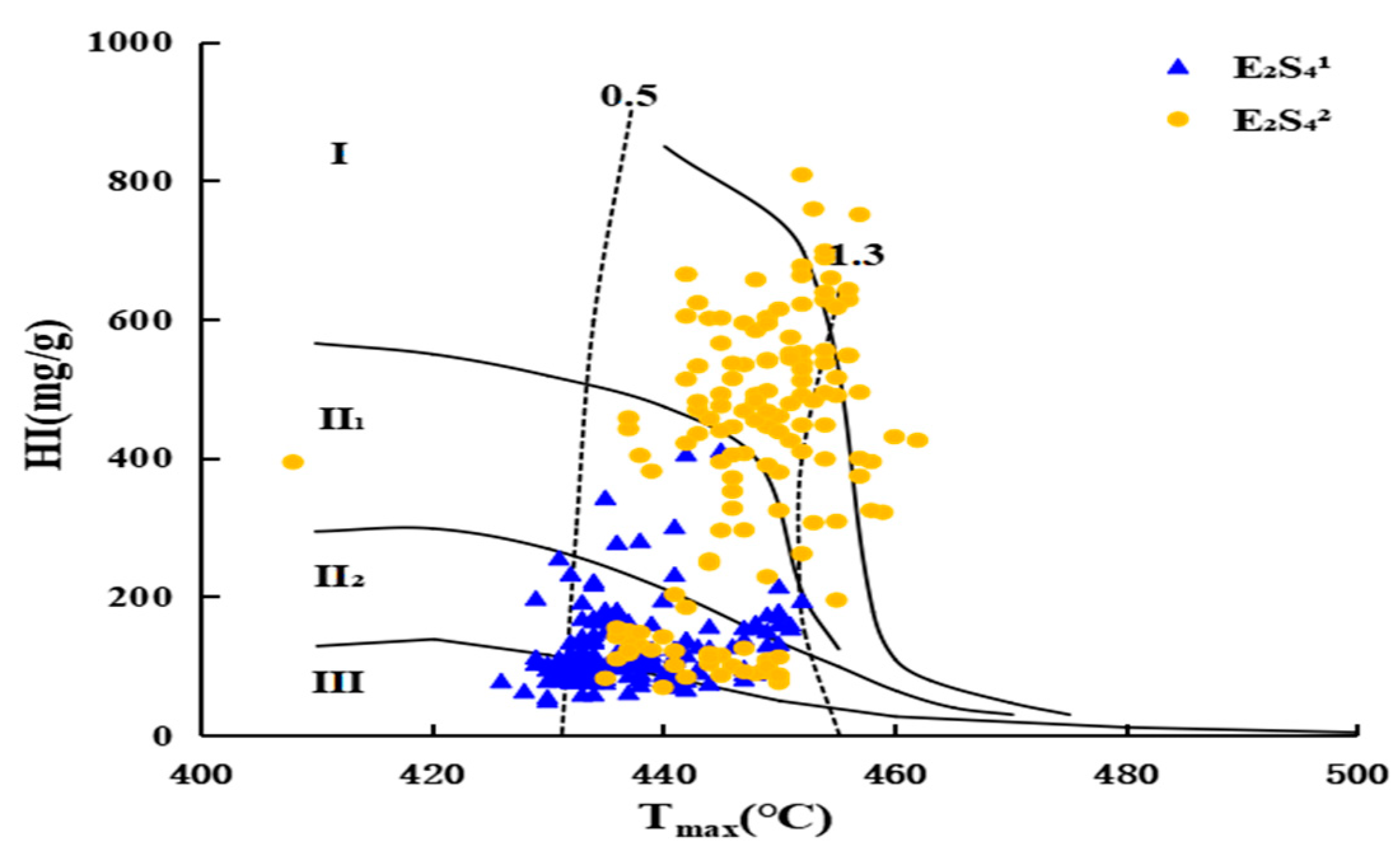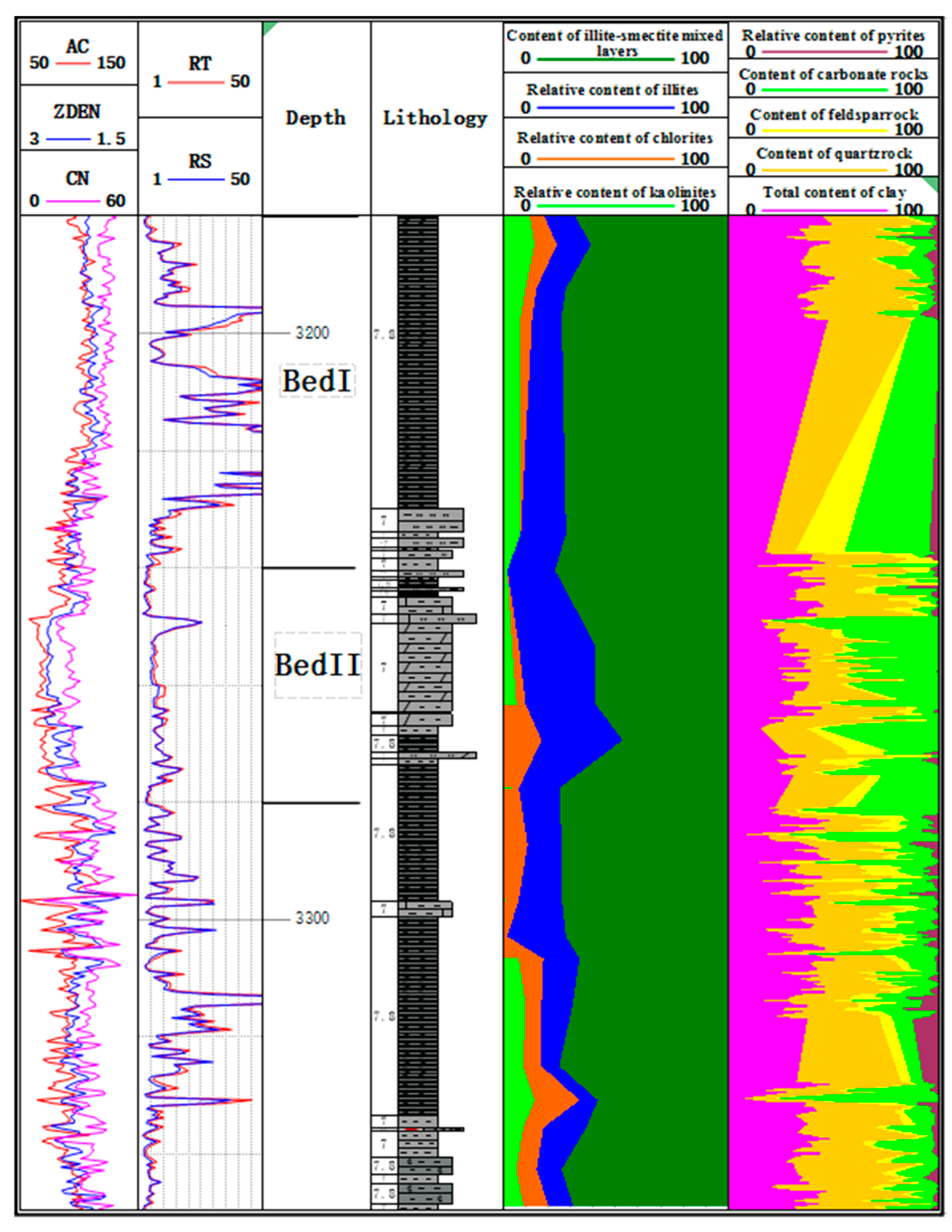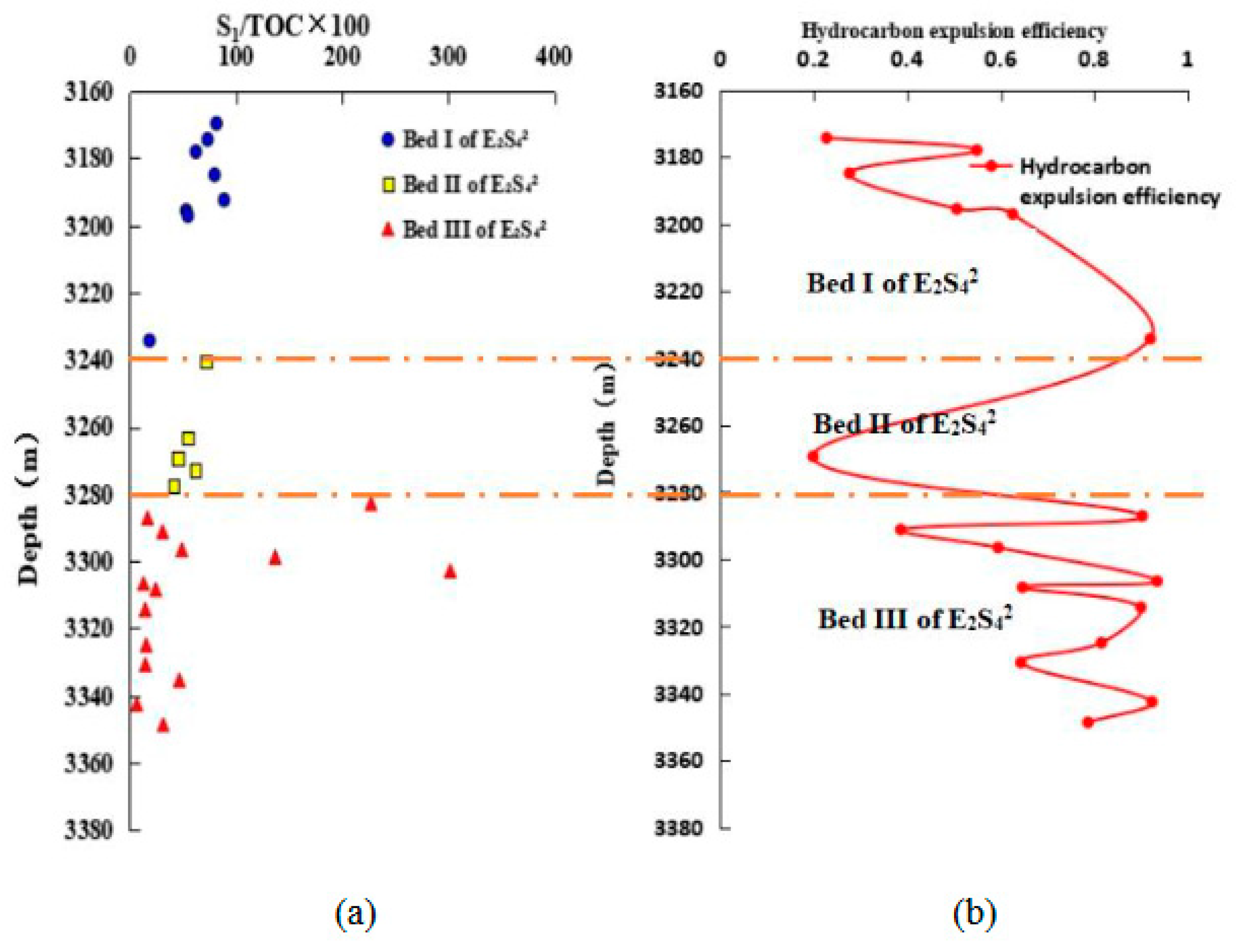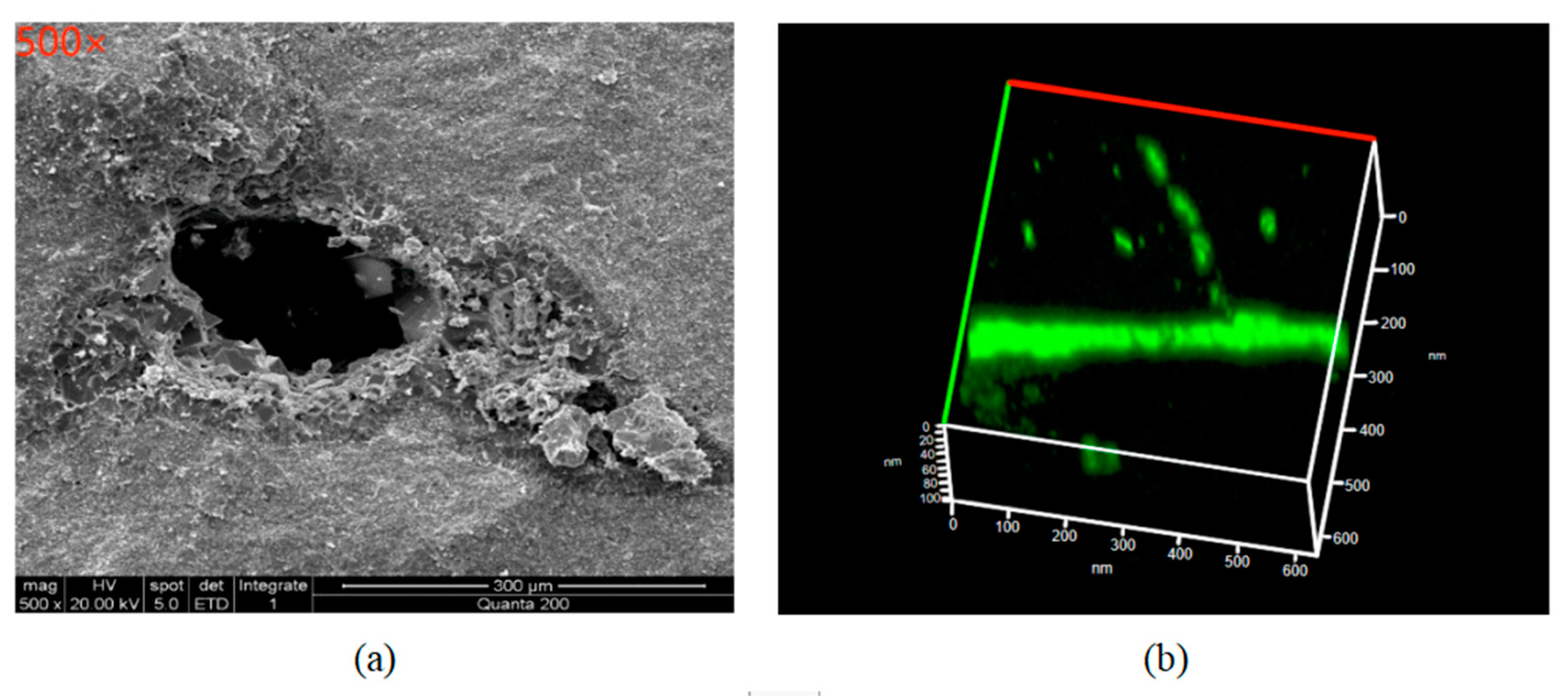Accumulation Conditions and Pattern of Tight Oil in the Lower Submember of the Fourth Member of the Shahejie Formation in the Damintun Sag, Bohai Bay Basin
Abstract
1. Introduction
Overview of the Study Area
2. Samples and Experiments
2.1. Sampling
2.2. Experiments and Analyses
2.2.1. Organic Carbon Analysis
2.2.2. Whole-Rock XRD Analysis
2.2.3. Field Emission Scanning Electron Microscopy (FE-SEM)
2.2.4. Confocal Laser Scanning Microscopy
2.2.5. Low-Temperature Nitrogen Adsorption
3. Results and Analysis
3.1. Source-Reservoir Conditions of Tight Oil
3.1.1. Source Rocks of Tight Oil
3.1.2. Tight Oil Reservoirs
3.2. Accumulation Conditions of Tight Oil
3.2.1. Effective Source Rocks in the E2S42 Submember Have High Organic Matter Abundance, Favorable Types of Organic Matter, and High Hydrocarbon Expulsion Efficiency, Providing Sufficient Oil Sources for Tight Oil Accumulation
3.2.2. During the Burial of Organic-Rich Shales, the Thermal Degradation of Organic Matter Produces Large Amounts of Organic Acids Which Dissolve Carbonate Minerals and Produce Massive Secondary Pores, Providing Favorable Reservoir Space for Tight Oil Accumulation
3.2.3. Special Microscopic Pore Structure That Connects Fractures to Pores Is the Key to the Enrichment of Tight Oil
3.2.4. Dolomitic Mudstones in the E2S42 Submember Have Significant Higher Breakthrough Pressure (Up to 100 Mpa) and Specific Surface Area Than Other Horizons, thus Effectively Sealing the Underlying Tight Reservoirs
3.3. Establishment of Tight Oil Accumulation Pattern
4. Conclusions
- (1)
- Beds I, II, and III of the E2S42 submember differ greatly in residual organic carbon. Bed II has obviously lower organic matter abundance than other beds, while beds I and III differ slightly in the restored original organic carbon. All three beds of the E2S42 submember mainly contain type I organic matter and small amounts of type II1 and II2 organic matter. Moreover, the target horizons all have entered the hydrocarbon generation stage and are mature.
- (2)
- The oil shales in the E2S42 submember are the main target horizons for tight oil enrichment in the Damintun Sag. They can be divided into beds I, II, and III from top to bottom, showing a distinct sandwich structure. Beds I and III consist mainly of dolomitic mudstones and siltstones, while bed II is primarily comprised of oil shales. The dissolution pores and microfractures in bed III have significantly higher density than those in the other beds, and dissolution pores are mostly distributed along fractures.
- (3)
- The tight oil in the Damintun Sag is typically self-generating and self-storing in oil shales, and its enrichment mainly depends on the oil-generation and reservoir conditions. The high-quality source rocks in the E2S42 submember have high original organic abundance, favorable original organic types, high hydrocarbon expulsion efficiency, and high fluidity, providing sufficient oil sources for tight oil accumulation. During the burial of organic-rich shales, the thermal degradation of organic matter produces large amounts of organic acids, which dissolve carbonate minerals. In this way, massive secondary pores are formed. The special microscopic pore structure that connects fractures to pores is the key factor for the high oil saturation of oil shale pores. The dolomitic mudstones in the E2S42 submember have significantly higher breakthrough pressure (up to 100 MPa) and specific surface area than other horizons, thus effectively sealing the underlying tight reservoirs.
Author Contributions
Funding
Data Availability Statement
Acknowledgments
Conflicts of Interest
References
- Zhang, K.; Sebakhy, K.; Wu, K.; Jing, G.; Chen, N.; Chen, Z.; Hong, A.; Torsæter, O. Future Trends For Tight Oil Exploitation. In Spe North Africa Technical Conference and Exhibition; SPE: Cairo, Egypt, 2015; pp. 44–49. [Google Scholar]
- Li, G.; Zhu, R. Progress, challenges and key issues of unconventional oil and gas development of CNPC. China Pet. Explor. 2020, 25, 1–13. [Google Scholar]
- Zou, C.N.; Pan, S.Q.; Jing, Z.H.; Gao, J.L.; Yang, Z.; Wu, S.T.; Zhao, Q. Shale oil and gas revolution and its impact. Acta Pet. Sin. 2020, 41, 1–12. [Google Scholar]
- Madden, B.; Vossoughi, S. US shale gas and tight oil boom: The opportunities and risks for America. In SPE Asia Pacific Oil and Gas Conference and Exhibition; SPE: Jakarta, Indonesia, 2013. [Google Scholar]
- Ghanizadeh, A.; Clarkson, C.R.; Aquino, S.; Ardakani, O.H.; Saneib, H. Petrophysical and geomechamical characteristics of Canadian tight oil and liquid-rich gas reservoirs: Pore network and permeability characterization. Fuel 2015, 153, 653–664. [Google Scholar] [CrossRef]
- Liu, B.; Bechtel, A.; Sachsenhofer, R.F.; Gross, D.; Gratzer, R.; Chen, X. Depositional environment of oil shale within the second member of Permian Lucaogou Formation in the Santanghu Basin, Northwest China. Int. J. Coal Geol. 2017, 175, 10–25. [Google Scholar] [CrossRef]
- Liu, B.; Yang, Y.; Li, J.G.; Chi, Y.; Li, J.H.; Fu, X. Stress sensitivity of tight reservoirs and its effect on oil saturation: A case study of Lower Cretaceous tight clastic reservoirs in the Hailar Basin, Northeast China. J. Pet. Sci. Eng. 2019, 184, 106484. [Google Scholar] [CrossRef]
- Luo, Q.; Fu, L.X.; Yang, W.; Liu, D.D.; Zhang, C.; Yu, J.X. Geological Characteristics of Typical Tight Oil Basins in The World; Petroleum Industry Press: Beijing, China, 2021; pp. 126–131. [Google Scholar]
- Daniel, A.; Brain, B.; Bobbi, J.C. Evaluatin implication of hydraulic fracturing in shale gas reservoirs. In Proceedings of the SPE Americas E&P Environmental and Safety Conference, San Antonio, TX, USA, 23–25 March 2009. [Google Scholar]
- Xia, D.L.; Wu, Y.; Xia, D.D.; Guo, X.J.; Zou, M. Characterization method of heterogeneity for Chang 8 tight reservoir in Honghe oil field, southern margin of Ordos Basin. Pet. Geol. Exp. 2021, 43, 704–712. [Google Scholar]
- Peng, S.C.; Zha, X.J.; Lei, X.H.; Fei, F.X.; Xu, D.S.; Gao, Y. Evolution characteristics and difference evaluation of shale oil reservoirs in the upper sweet spot interval of Lucaogou Formation in Jimusaer Sag. Spec. Oil Gas Reserv. 2021, 28, 30–38. [Google Scholar]
- Kang, Y.Z. Prospect analysis of Carboniferous-Permian tight oil and gas resources in northern China. Fault-Block Oil Gas Field 2020, 27, 681–683. [Google Scholar]
- Song, Y.; Luo, Q.; Jiang, Z.; Yang, W.; Liu, D. Enrichment of tight oil and its controlling factors in central and western China. Pet. Explor. Dev. 2021, 48, 421–433. [Google Scholar] [CrossRef]
- Tang, W.Y.; Shang, Y.Z.; James, S.; Wang, X.; Zou, F. Evaluation of the EOR potential of the Fuyu tight oil reservoir in Aonan area of Daqing Oilfield. Fault-Block Oil Gas Field 2021, 1, 51–56. [Google Scholar]
- Zou, C.N.; Zhu, R.K.; Wu, S.T.; Tao, S.Z.; Yuan, X.J.; Hou, L.H.; Yang, H.; Xu, C.C.; Li, D.H.; Bai, B.; et al. Types, characteristics, genesis and prospects of conventional and unconventional hydrocarbon accumulations: Taking tight oil and tight gas in China as an instance. Acta Pet. Sin. 2012, 33, 173–187. [Google Scholar]
- Guo, M.L.; Chen, Y.; Zheng, Z.H.; Li, J.; Yu, L.; Liu, L.Q. Rapid evaluation of probable recoverable reserves in tight reservoirs: A case study of Chang 8 reservoir (eighth member of Yanchang Formation) in Honghe oil field. Pet. Geol. Exp. 2021, 43, 154–160. [Google Scholar]
- Fattouh, B.; Sen, A. The Us Tight Oil Revolution in A Global Perspective; University of Oxford: Oxford, UK, 2013; pp. 1–12. [Google Scholar]
- Hu, S.Y.; LI, J.Z.; Wang, T.S.; Wang, Z.C.; Yang, T.; Li, X.; Hou, L.H.; Yuan, X.J.; Zhu, R.K.; Bai, B.; et al. CNPC oil and gas resource potential and exploration target selection. Pet. Geol. Exp. 2020, 42, 813–823. [Google Scholar]
- Fang, X.X.; Guo, Y.C.; Wang, P.; Wang, P.W.; Guo, J.G. The progress of research on tight oil accumulation and several scientific issues requiring further study. Geol. China 2020, 47, 43–56. [Google Scholar]
- Liu, W.F.; Zhang, X.Y.; Sheng, S.Y.; Wang, K.; Duan, Y.G.; Wei, M.Q. Research on a new combination method of production decline analysis for tight oil: Cases study of Mahu tight reservoir. Reserv. Eval. Dev. 2021, 11, 911–916. [Google Scholar]
- Kalani, M.; Jahren, J.; Mondol, N.H.; Faleide, J.I. Petrophysical implications of source rock microfracturing. Int. J. Coal Geol. 2015, 143, 43–67. [Google Scholar] [CrossRef]
- Yang, D.Q. Analysis on the lithology and reservoir conditions of Archaeozoic buried hill in Damintun depression. Explor. Dev. 2020, 27, 88 + 95. (In Chinese) [Google Scholar]
- Zhang, W.W. Microcosmic characteristics of fine-grained sedimentary reservoirs and its application—By taking S352 well in Anfutun area of Damintun sag as an example. Pet. Geol. Eng. 2019, 33, 11–15. (In Chinese) [Google Scholar] [CrossRef]
- Ross, D.J.K.; Bustin, R.M. Characterizing the shale gasresource potential of Devonian-Mississippian strata in theWestern Canada sedimentary basin: Application of anintegrated formation evaluation. AAPG Bull. 2008, 92, 87–125. [Google Scholar] [CrossRef]
- Mao, Y.Q.; Li, N.; Cao, K.F.; Wang, P.M.; Zhang, Y.; Wang, D.Y. Quantitative prediction technology of TOC of continental mud shale in Songnan area. Fault-Block Oil Gas Field 2020, 27, 313–334. [Google Scholar]
- Hubert, F.; Caner, L.; Meunier, A.; Ferrage, E. Unraveling complex <2μm clay mineralogy from soils using X-ray diffraction profile modeling on particle-size sub-fractions: Implications for soil pedogenesis and reactivity. Am. Mineral. 2012, 97, 384–398. [Google Scholar]
- Jiao, S.J.; Zhang, H.; Xue, D.C.; Huang, Z.L.; Liu, G.H. Morphological structure and identify method of organic macerals of shale with SEM. J. Chin. Electron Microsc. Soc. 2018, 37, 137–144. [Google Scholar]
- Loucks, R.G.; Reed, R.M.; Ruppel, S.C.; Hammes, U. Spectrum of pore types and networks in mudrocks and a descriptive classification for matrix-related mudrock pores. AAPG Bull. 2012, 96, 1071–1098. [Google Scholar] [CrossRef]
- Liu, B.; Schieber, J.; Mastalerz, M. Combined SEM and reflected light petrography of organic matter in the New Albany shale (Devonian-Mississippian) inthe Illinois Basin: A perspective on organic pore development with thermal maturation. Int. J. Coal Geol. 2017, 184, 57–72. [Google Scholar] [CrossRef]
- Aplin, A.C.; Macleod, G.L.; Arter, S.; Pedersen, K.S.; Sorensen, H.; Booth, T. Combined use of confocal laster microscopy and PVT simulation for estimating the composition and physical properties of petroleum in fluid inclusions. Mar. Pet. Geol. 1999, 16, 97–110. [Google Scholar] [CrossRef]
- Zhang, L.C.; Lu, S.F.; Xiao, D.S.; Li, B. Pore structure characteristics of tight sandstones in the northern Songliao Basin, China. Mar. Pet. Geol. 2017, 88, 170–180. [Google Scholar] [CrossRef]
- Huang, Z.K.; Chen, J.P.; Wang, Y.J.; Deng, C.P.; Xue, H.T. Pore distribution of source rocks as revealed by gas adsorption and mercury injection methods: A case study on the first member of the Cretaceous Qingshankou Formation in the Songliao Basin. Geol. Rev. 2013, 59, 587–595. [Google Scholar]
- Li, X.G.; Liu, X.Z.; Li, J.P.; Tian, Z. Comprehensive evaluation and exploration practice of lacustrine shale oil in the fourth member of Shahejie Formation in Damintun Sag, Liaohe Depression. China Pet. Explor. 2019, 24, 636–648. [Google Scholar]
- Xie, Q.C.; Feng, B.; Song, P.; Liu, G.F.; Liu, J.; Zhang, T.H. Fractal characteristics of microscopic pore-throat structures of Chang 7 tight sandstone reservoirs, Heshui area, Ordos Basin. Fault-Block Oil Gas Field 2019, 26, 215–219. [Google Scholar]
- Meng, Y.L.; Li, N.; Huang, W.B.; Xiao, L.H.; Liu, D.L.; Zhang, Q.J.; Sun, H.B.; Xiu, H.W. Diagenetic facies analysis and high quality reservoir prediction of the Cenozoic in southern segment of western slope of Liaohe Depression. J. Palaeogeogr. 2008, 10, 33–41. (In Chinese) [Google Scholar]









| Type of Tight Oil | Reservoir-Forming Factors | |||||
|---|---|---|---|---|---|---|
| Source-Reservoir Configuration | Hydrocarbon Expulsion Channel | Hydrocarbon Expulsion Efficiency | Organic Matter Abundance | Fracture Density | Filling Resistance | |
| Tight oil in oil shales | Self-generation and self-storage | Fractures | Relatively high | High | High | Low |
| Tight oil of sandstones | Superimposed sources and reservoirs | Pore throats | Relatively low | Low | Low | High |
Disclaimer/Publisher’s Note: The statements, opinions and data contained in all publications are solely those of the individual author(s) and contributor(s) and not of MDPI and/or the editor(s). MDPI and/or the editor(s) disclaim responsibility for any injury to people or property resulting from any ideas, methods, instructions or products referred to in the content. |
© 2023 by the authors. Licensee MDPI, Basel, Switzerland. This article is an open access article distributed under the terms and conditions of the Creative Commons Attribution (CC BY) license (https://creativecommons.org/licenses/by/4.0/).
Share and Cite
Wang, W.; Liu, Q.; Jing, W.; Yan, Y.; Zhang, S.; Tian, W. Accumulation Conditions and Pattern of Tight Oil in the Lower Submember of the Fourth Member of the Shahejie Formation in the Damintun Sag, Bohai Bay Basin. Processes 2023, 11, 135. https://doi.org/10.3390/pr11010135
Wang W, Liu Q, Jing W, Yan Y, Zhang S, Tian W. Accumulation Conditions and Pattern of Tight Oil in the Lower Submember of the Fourth Member of the Shahejie Formation in the Damintun Sag, Bohai Bay Basin. Processes. 2023; 11(1):135. https://doi.org/10.3390/pr11010135
Chicago/Turabian StyleWang, Weiming, Qingguo Liu, Wenping Jing, Youguo Yan, Shuxia Zhang, and Weichao Tian. 2023. "Accumulation Conditions and Pattern of Tight Oil in the Lower Submember of the Fourth Member of the Shahejie Formation in the Damintun Sag, Bohai Bay Basin" Processes 11, no. 1: 135. https://doi.org/10.3390/pr11010135
APA StyleWang, W., Liu, Q., Jing, W., Yan, Y., Zhang, S., & Tian, W. (2023). Accumulation Conditions and Pattern of Tight Oil in the Lower Submember of the Fourth Member of the Shahejie Formation in the Damintun Sag, Bohai Bay Basin. Processes, 11(1), 135. https://doi.org/10.3390/pr11010135












